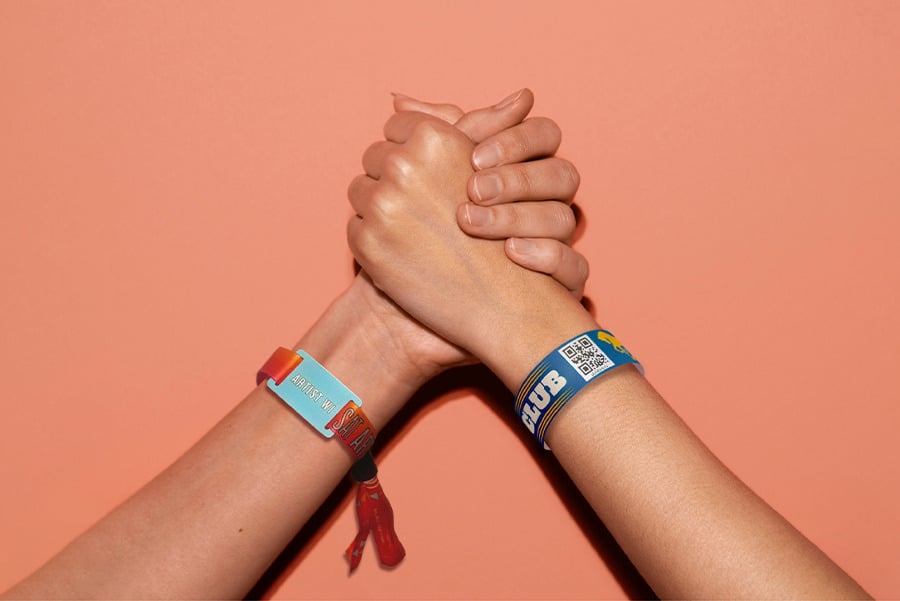In today's fast-paced world, event organizers need cutting-edge technology to ensure their festivals run smoothly. Choosing the right event technology is vital, as it can make or break the attendee experience. With options like RFID, NFC, barcodes, and QR codes at your disposal, the decision can be overwhelming. In this guide, we'll explore these technologies and help you determine which one is best for your festival.
Overview of RFID, NFC, Barcodes, and QR Codes
To make an informed choice, let's start with an overview of these four event technologies:
- RFID (Radio-Frequency Identification): RFID technology uses radio waves to communicate between a reader and an RFID tag. It can store a large amount of information and is commonly used for tracking and identification.There are three types of RFID tags: low-frequency (LW), high-frequency(HF), and ultra high-frequency(UHF) tags. HF RFID tags are used for ticketing, access control, and cashless payments whereas UHF RFID tags are used for inventory management.
- NFC (Near Field Communication): NFC is a subset of HF RFID that enables short-range communication between devices. It's a two-way communication technology that's used for data exchange between smartphones, event badges, or other NFC-enabled devices.
- Barcodes: Barcodes are visual representations of information, consisting of parallel black lines called bars. Scanners read the codes and translate them into data for various applications.
- QR Codes (Quick Response Codes): QR codes are two-dimensional barcodes that can store a significant amount of information. They're commonly scanned using smartphone cameras to access websites, links, or information.
Each of these technologies has unique features and use cases.
How Does RFID Work?
RFID technology relies on the interaction between two essential components: the RFID reader and the RFID tag. The reader emits radio waves that are received by tags with the help of attached antennas. The radio waves activate the tag, allowing it to relay its stored information. These tags come in two variations, active and passive, where active tags operate on their power supply, while passive tags harness the energy from the reader's signal to power their operations. Read our blog “How do RFID wristbands work” to know more.
RFID Applications in Events
RFID technology finds extensive use in event management. It can be employed for various tasks, including:
- Ticketing: RFID wristbands or event badges can serve as electronic tickets, providing a quick and secure entry process and reducing the line-up outside events considerably.
- Access Control: RFID technology ensures smooth access control by verifying attendee credentials, and keeping gate crashers at bay.
- Cashless Payments: Through RFID-enabled wearables or badges, patrons can pay for food, drinks, or make any other purchases in the event with just the convenience of a contactless tap.
- Inventory Management: UHF RFID helps organizers keep track of equipment, merchandise, and more.
- Customer Engagement: RFID can enhance the attendee experience through interactive activities like scavenger hunts and social media integrations.
How Does NFC Work?
NFC, or Near Field Communication, enables short-range wireless communication between devices, like smartphones and badges. For NFC to work, two devices must be in very close proximity, within a few centimeters. One device takes an active role, generating a magnetic field that powers the passive device. Data exchange occurs, with information sent from the active device to the passive one, often secured by NFC Forum standards. NFC is secure due to its close physical interaction, making eavesdropping difficult.
NFC Applications in Events
In the context of events, NFC has several applications, including:
- Registration: Attendees can register by simply tapping their NFC-enabled devices, streamlining the check-in process.
- Networking: By tapping NFC business badges on smartphones, business professionals and industry experts can network easily in conferences .
- Payments: It allows for seamless cashless transactions at festival concessions.
- Attendee Engagement: Attendees can interact with brand activations, gain access to exclusive content, and share their experiences using NFC technology.
How Do Barcodes Work?
Barcodes are visual patterns used to encode information that optical scanners, or barcode readers, can interpret. They typically consist of parallel lines (bars) and spaces of varying widths. When scanned, a light source is used to illuminate the barcode, and a sensor detects the reflected light or its absence in the spaces between the bars. The scanner deciphers the widths and spacings, converting them into specific data, often in binary or alphanumeric format. Barcodes are a versatile tool for encoding data like product numbers, prices, or inventory details, making them essential for efficient data entry and management in various applications.
Barcode Applications in Events
Barcodes have a range of applications in events, such as:
- Labeling and Tracking: Barcodes are used for labeling, simplifying the tracking and organization of materials.
- Check-In: They enable fast and efficient check-in processes for attendees.
- Inventory Management: Barcodes help keep inventory levels in check during events.
How Do QR Codes Work?
QR codes, or Quick Response codes, work by encoding data in a two-dimensional matrix of black squares on a white background. When a smartphone's camera scans a QR code, it reads the pattern of squares and converts it into data, such as a web link, contact details, or other information. QR codes can store a significant amount of data, making them versatile for various applications. Their simplicity and ability to be scanned with a smartphone camera have made QR codes a commonly used technology in day-to-day life.
QR Code Applications in Events
QR codes have become invaluable in events, where they are used for:
- Event Marketing: QR codes can promote events by providing quick access to event websites, videos, and promotional materials.
- Engagement: Attendees can scan QR codes to access interactive experiences, such as quizzes, surveys, and games.
- Ticketing and Access Control: QR codes serve as electronic tickets, providing a convenient and paperless option for entry.
Now that we have a foundational understanding of these technologies, let's compare them for festival applications.
RFID vs. NFC for Festivals
RFID and NFC are closely related technologies, but they have some distinct differences. RFID operates using one-way communication and can store a vast amount of information on tags. On the other hand, NFC facilitates two-way communication between devices and operates within a short range. In festival settings, HF RFID wristbands are ideal for applications like ticketing, access control, and social media promotions, while NFC excels in registration, networking, and audience engagement. However, between the two technologies, RFID is preferred over NFC in the hospitality industry.
RFID vs. Barcodes for Festivals
When comparing RFID and barcodes, RFID tags have the advantage of security and reliable scan faster scan, not to mention cashless payments. Barcodes, however, are prone to getting damiged affecting scalability , and have a slower read time. In festival applications, RFID is advantageous attendee engagement, while barcodes are suitable for labeling and ticketing.
NFC vs. QR Code for Festivals
NFC and QR codes both have their unique applications and benefits for festivals. While both technologies are associated with mobile devices, NFC facilitates more secure interactions and payments, making it ideal for registration, access control, and cashless transactions. QR codes and NFC, are both effective for event marketing, engagement, and providing event details to attendees.
Which Is the Best Event Technology for Festivals?
The choice between RFID, NFC, barcodes, and QR codes depends on your festival's specific needs and objectives. Here are some scenarios where each technology shines:
- RFID: Opt for RFID if you need fast robust access control, cashless payments, . It's a versatile reliable technology suitable for large festivals.
- NFC: Choose NFC if you want to offer seamless networking, secure access control, and cashless payments. It's perfect for enhancing the attendee experience.
- Barcodes: Barcodes are a cost-effective choice for smaller festivals with simpler requirements. They work well for basic ticketing and inventory tracking.
- QR Codes: QR codes are excellent for marketing, engagement, and providing information to attendees. They are suitable for events with a strong focus on digital engagement.
You can even integrate more than one event technology with your existing systems. If you had to choose one, you can’t go wrong with RFID as major festivals and concerts across the globe rely on RFID event badges and wristbands to host successful events.
Ultimately, the best event technology for your festival will depend on your unique goals. It's essential to carefully assess your event's needs and explore the technology that aligns with your vision for a successful festival experience.







